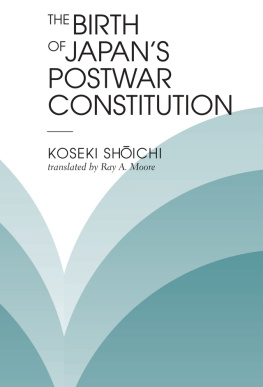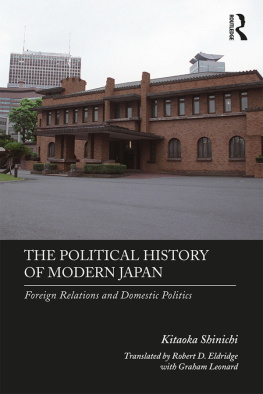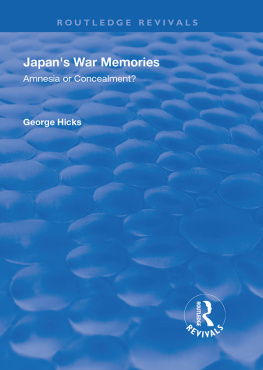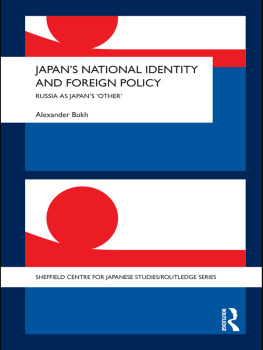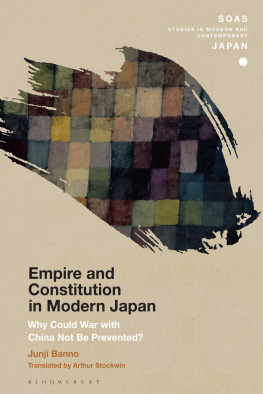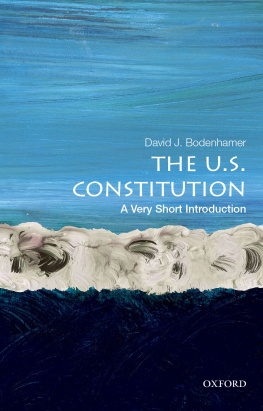The Birth of Japan's Postwar Constitution
The Birth of Japan's Postwar Constitution
Koseki Shichi
Edited and Translated By
Ray A. Moore
To my grandchildren, Nicholas and Kelsey
First published 1997 by Westview Press
Published 2018 by Routledge
711 Third Avenue, New York, NY 10017, USA
2 Park Square, Milton Park, Abingdon, Oxon OX14 4RN
Routledge is an imprint of the Taylor & Francis Group, an informa business
Copyright 1997 by Taylor & Francis
All rights reserved. No part of this book may be reprinted or reproduced or utilised in any form or by any electronic, mechanical, or other means, now known or hereafter invented, including photocopying and recording, or in any information storage or retrieval system, without permission in writing from the publishers.
Notice:
Product or corporate names may be trademarks or registered trademarks, and are used only for identification and explanation without intent to infringe.
Library of Congress Cataloging-in-Publication Data
Koseki, Shichi, 1943
[Shin Kenp no tanj. English]
The birth of Japan's postwar constitution / Koseki Shichi;
edited and translated by Ray A. Moore.
p. cm.
Includes bibliographical references.
ISBN 0-8133-3162-5 (hc) ISBN 0-8133-3495-0 (pb)
1. Constitutional historyJapan. 2. JapanPolitics and
government1945 I. Moore, Ray A., 1933. II. Title.
KNX2101.K6713 1997
342.52'029dc21 97-4511
CIP
ISBN 13: 978-0-8133-3495-0 (pbk)
Throughout the translating of this book I have benefited from the support of colleagues at Amherst, Mount Holyoke, and Smith Colleges and Doshisha University in Japan. I wish to thank in particular Uda Yoshi-tada and Wako Tawa for numerous suggestions for translating difficult passages and Tadanori Yamashita for assisting me with the text on many occasions and for translating the "Constitution songs" in .
The author, Koseki Shichi, has spent many hours with me in Japan and Massachusetts going over passages, events, and names. His willingness to share his notes on his sources, including many in English, saved me many hours of searching and translating. He also helped secure a foundation grant to defray the costs of publication. John Dower and Kyoko Inoue not only offered personal encouragement but wrote letters of recommendation for the publishing subsidy. I owe a deep debt of gratitude to Charles Kades and Donald Robinson whose knowledge and understanding of the origins of Japan's postwar constitution have been a constant challenge to me. And I wish to thank my wife, Ilga, for her constant assistance and moral support.
I must thank Japan's Association of 100 Titles for the grant that made the project possible, as well as the Tokio Kaijo Kagami Kinan Zaidan (Tokyo Marine Kagami Memorial Foundation) for the publication subsidy. A special word of gratitude is due Cynthia Gralla for her careful reading of and editorial suggestions and Mark Vanhoenacker for help in the final stages of preparing the electronic manuscript. Finally, I am grateful to my copyeditor, Jennifer Barrett, and to the editorial staff of Westview Press, especially Susan McEachern and Carol Jones, who have helped at every stage. For whatever errors and deficiencies remain, I alone am responsible.
Ray A. Moore
Northfield, Massachusetts
Japanese names in the text are given in Japanese order, that is, surname first and given name second. In the transcription of Japanese words, macrons are used to indicate long vowels except in the case of common place names. In some English sources Konoe Fumimaro is referred to as Konoye.
All material in brackets has been inserted by the translator. Unless otherwise noted, brackets in the original Japanese have been changed to parentheses by the translator. Whenever possible the translator has used the original sources in English rather than retranslated from Japanese.
When I was finishing the writing of this book at the beginning of 1989, the Shwa period (1926-1989) came to an end. The death of Emperor Shwa revealed to me clearly that the Japanese people's feelings toward their emperor had not changed much since before the war. With the emperor's death all the television channels were offering programs related to him. All the employees of Japanese automobile companies, which represent Japan, were shown on television bowing most reverently toward the imperial palace.
For most Japanese intellectuals and especially for those who had put their faith in democracy, the half year surrounding the emperor's death was without doubt a melancholy time. Needless to say I was holding my head in my small study.
Until at least the 1970s most of the books written by Japanese, both those on postwar Japanese history and those on postwar legal history, depicted Japan's prewar and postwar political systems as completely different, that is, depicted a sharp break between the prewar and postwar periods. Many of the books published between 1945 and the 1960s especially emphasized this break in modern Japanese history. I recall clearly as a student being taught by a progressive professor that "there is only a very slight difference between the symbolic emperor system and a republican form of government."
Certainly the reforms carried out by the American occupation forces immediately after the war rivaled the Meiji Restoration in Japan in terms of their significance. Of these reforms, the Japanese Constitution drafted by General Douglas MacArthur's staff was epoch-making and was greeted by most Japanese with great surprise. But for about ten years after it was adopted, the constitution was not an important political issue. Those iii the conservative camp were unhappy with this constitution but, being under a foreign military occupation, were unable to raise their voices in protest; they also had no political ideas for preparing a different constitution to replace this one. Those in the progressive camp under Marxist influence had much greater interest in a "people's revolution" than in this constitution. Most people who belonged to neither camp had little concern for the constitution. From their experience with the Meiji Constitution, the new constitution was not something that had to do with their own human rights and consequently the Japanese Constitution was far removed from their lives.
The constitution only became a central political issue after Japan signed peace and security treaties in 1951 and became a member of tine western camp and after the Korean War (1950-1953), when proposals were made under a conservative government to revise the constitution to make rearmament possible, to strengthen the emperor's position, and to restore the traditional family system.
These ideas for revising the constitution responded to the American demand that Japan rearm and, at the same time, included Meiji period constitutional values, which were based on the nationalism that the Japanese people had carried over from the prewar period. When ideas for revision were set forth, nationalist feelings appeared clearly in the argument that, because the constitution had been imposed on Japan by the American occupation, a new "independent constitution" should be written by the Japanese people themselves.
By contrast, the progressives took the position of opposing rearmament and protecting the Japanese Constitution, thus making the constitution the point of contention and setting up a conflict over Article 9, which prohibited the maintenance of military forces.

